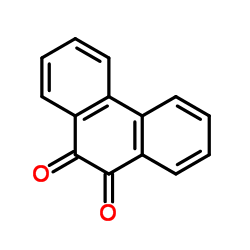Phenanthrene-9,10-dione

Phenanthrene-9,10-dione structure
|
Common Name | Phenanthrene-9,10-dione | ||
|---|---|---|---|---|
| CAS Number | 84-11-7 | Molecular Weight | 208.212 | |
| Density | 1.3±0.1 g/cm3 | Boiling Point | 360.0±0.0 °C at 760 mmHg | |
| Molecular Formula | C14H8O2 | Melting Point | 209-212 °C(lit.) | |
| MSDS | Chinese USA | Flash Point | 163.1±4.4 °C | |
| Symbol |

GHS07 |
Signal Word | Warning | |
|
Fluorescence Titrations of Bio-relevant Complexes with DNA: Synthesis, Structural Investigation, DNA Binding/Cleavage, Antimicrobial and Molecular Docking Studies.
J. Fluoresc. 25 , 1127-40, (2015) In the present work, we attempted to develop new metal complexes (Cu(II), Co(II), Ni(II) and Zn(II)) of the imine ligand which was synthesized from 9,10-phenanthrenequinone and para-anisidine. With an intention to make the complexes most stable, very special ... |
|
|
Sulfa drugs inhibit sepiapterin reduction and chemical redox cycling by sepiapterin reductase.
J. Pharmacol. Exp. Ther. 352(3) , 529-40, (2015) Sepiapterin reductase (SPR) catalyzes the reduction of sepiapterin to dihydrobiopterin (BH2), the precursor for tetrahydrobiopterin (BH4), a cofactor critical for nitric oxide biosynthesis and alkylglycerol and aromatic amino acid metabolism. SPR also mediate... |
|
|
3-Deoxyglucosone: a potential glycating agent accountable for structural alteration in H3 histone protein through generation of different AGEs.
PLoS ONE 10(2) , e0116804, (2015) Advanced glycation end-products (AGEs) are heterogeneous group of compounds, known to be implicated in diabetic complications. One of the consequences of the Maillard reaction is attributed to the production of reactive intermediate products such as α-oxoalde... |
|
|
Nucleoid compaction by MrgA(Asp56Ala/Glu60Ala) does not contribute to staphylococcal cell survival against oxidative stress and phagocytic killing by macrophages.
FEMS Microbiol. Lett. 360(2) , 144-51, (2014) Staphylococcus aureus MrgA (encoded by mrgA) belongs to the Dps family of proteins, which play important roles in coping with various stresses. The staphylococcal mrgA gene is specifically expressed under oxidative stress conditions and is one of the most hig... |
|
|
Naturally occurring variants of human aldo-keto reductases with reduced in vitro metabolism of daunorubicin and doxorubicin.
J. Pharmacol. Exp. Ther. 335 , 533-545, (2010) Doxorubicin (DOX) and daunorubicin (DAUN) are effective anticancer drugs; however, considerable interpatient variability exists in their pharmacokinetics. This may be caused by altered metabolism by nonsynonymous single-nucleotide polymorphisms (ns-SNPs) in g... |
|
|
Method development for the measurement of quinone levels in urine.
J. Chromatogr. B. Analyt. Technol. Biomed. Life Sci. 879(30) , 3592-8, (2011) A method was developed for the quantification of 1-4 ring quinones in urine samples using liquid-liquid extraction followed by analysis with gas chromatography-mass spectrometry. Detection limits for the ten quinones analyzed are in the range 1-2 nmol dm(-3).... |
|
|
NADP(+)-dependent dehydrogenase activity of carbonyl reductase on glutathionylhydroxynonanal as a new pathway for hydroxynonenal detoxification.
Free Radic. Biol. Med. 83 , 66-76, (2015) An NADP(+)-dependent dehydrogenase activity on 3-glutathionyl-4-hydroxynonanal (GSHNE) was purified to electrophoretic homogeneity from a line of human astrocytoma cells (ADF). Proteomic analysis identified this enzymatic activity as associated with carbonyl ... |
|
|
Advanced Glycation-Modified Human Serum Albumin Evokes Alterations in Membrane and Eryptosis in Erythrocytes.
Appl. Biochem. Biotechnol. 177 , 1013-24, (2015) Increased burden of advanced glycation end-products (AGEs) in case of hyperglycemic conditions leads to the development of retinopathy, nephropathy, and cardiovascular and neurological disorders such as Alzheimer's disease. AGEs are considered as pro-oxidants... |
|
|
Identification of metabolites from phenanthrene oxidation by phenoloxidases and dioxygenases of Polyporus sp. S133.
J. Microbiol. Biotechnol. 21(3) , 299-304, (2011) Phenanthrene degradation by Polyporus sp. S133, a new phenanthrene-degrading strain, was investigated in this work. The analysis of degradation was performed by calculation of the remaining phenanthrene by gas chromatography-mass spectrometry. When cells were... |
|
|
9,10-Phenanthrenedione biodegradation by a soil bacterium and identification of transformation products by LC/ESI-MS/MS.
Chemosphere 92(11) , 1442-9, (2013) Transformation of 9,10-phenanthrenedione, a cytotoxic derivative of phenanthrene, was shown to occur by a soil bacterium belonging to the genus Sphingobium. Phenanthrene-grown cells of this strain were exposed to 50mgL(-1) 9,10-phenanthrenedione in liquid cul... |